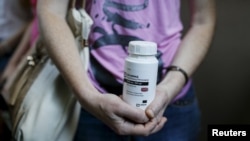Donor countries that contribute the lion’s share of funding to fight the global HIV epidemic have put the brakes on financial assistance.
A new report found that more than half of the governments decreased their contributions to low- and middle-income countries to fight HIV/AIDS, with only a modest increase in assistance by some countries.
In 2014, donations from the 14 primary donor governments for HIV control and prevention was $8.6 billion, an amount that has remained more or less stagnant for two years.
Jennifer Kates, director of Global Health and HIV Policy at Kaiser Family Foundation, helped assemble the report along with UNAIDS.
Kates said many Western countries have run up against the financial realities of budget cutbacks, and the pace of donations dedicated to helping fight HIV has begun to slow.
“At the same time, to get to where public health officials and scientists and policy makers feel we can get to with what is known about HIV, more needs to be done and that is a hard sell to donors and others who have many, many priorities right now,” she said.
The U.S. government remains the largest donor to the Global Fund to Fight AIDS, contributing $5.6 billion in 2014. That represented a modest, adjusted increase of one percent over 2013 levels.
Britain was the second biggest contributor at $1.1 billion.
Germany’s contribution remained flat in 2014, while the EU, Australia, Canada, Denmark and France decreased their assistance.
Kates said the financial support from donor countries has been key to fighting the AIDS epidemic, but stressed that resources need to be icnreased.
“So, it is a lot of money on the one hand from donors and others, but it’s still not enough to meet that goal and turn around the epidemic,” she added.
UNAIDS said in a press release that the total global investment from all sources in response to the AIDS crisis is around $22 billion a year.
"That would need to be increased by $8-$12 billion a year in order to meet the Fast-Track Target of $31.9 billion in 2020," the statement said. "By meeting the 2020 target, the need for resources would begin to permanently decline, reducing to $29.3 billion in 2030 and far less in the future. This would produce benefits of more than $3.2 trillion that extend well beyond 2030."
Public health experts estimate that $30 billion is needed annually by 2030 to begin to end the crisis.






